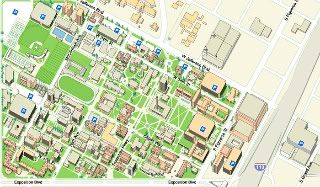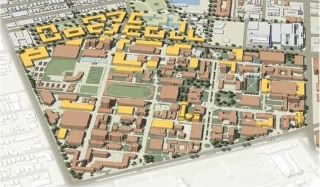USC has big plans for the future development of the University Park Campus but all Zachary Williams wants is a closer parking spot.
“Not all pedestrians are created equal,” said Zachary Williams who is a double amputee from the knee down after being born without shinbones. “Not everyone can park on the other side of Figueroa.”
 According to the 2030 Master Plan, released this year, the school plans to maximize space and revitalize the campus by replacing surface parking lots with new buildings. Though with ample parking in structures on the perimeter of campus, it is closer handicap spots that are becoming endangered. Current construction has displaced over 300 on-campus parking spaces, according to Trojan Transportation.
According to the 2030 Master Plan, released this year, the school plans to maximize space and revitalize the campus by replacing surface parking lots with new buildings. Though with ample parking in structures on the perimeter of campus, it is closer handicap spots that are becoming endangered. Current construction has displaced over 300 on-campus parking spaces, according to Trojan Transportation.Picture: Zachary Williams at the Office of International Studies where he works as an Exchange Visitor Program Coordinator.
“Land is too valuable,” said the Vice President of Campus Development Curt Williams, no relation to Zachary Williams. “I wouldn’t be surprised if all the surface lots are gone in the next 20 years.”
The Master Plan sets out loose guidelines for the physical future of the campus. The language dedicated to parking reads, “locate the majority of parking resources at the campus perimeter for convenient access and the enhancement of a pedestrian-oriented campus.”
“We didn’t get into great detail with where all these handicap spots are going to go,” said Curt Williams.
University parking works on a pool system, meaning the number of spaces required by the city is determined by a formula calculating square footage of buildings, number of bedrooms in dorms and seats in auditoriums. However, the city only mandates the number of spots, not the location or proximity of destination. The construction of a new building on campus sets off a domino reaction of parking problems.
For example, when the University decided to rebuild the student commons area, administrators knew they needed to build a temporary place for students to eat while construction occurred. The solution was the tent structure aptly named The Lot that was built on parking lot K2.
“We get word we are losing those spots and we try to replace them somewhere,” said Tony Mazza, Director of Transportation. “The decision to build is made way in the future and then we will eventually be notified when we need to relocate a spot or re-stripe a handicap spot.”
It is a juggling act for Transportation to maintain harmony with the parking demands for the VIP’s, faculty, handicapped, and student body. One parking lot that has caused added stress is the surface spots on Child’s Way.
“Child’s Way is sacred ground. There is Town and Gown, the theaters, VIP’s – and you have to find a balance between all the customers,” Mazza said.
The temporary food court displaced not just the parking lot it was built on, but another smaller lot closer to the bookstore—the reserved parking for President Sample and The Board of Trustees. To make up for the loss of those two lots, Trojan Transportation relocated the VIP spaces to Child’s Way, painted over the handicap markings and added an automatic arm to secure the lot.
President Sample now parks in a former handicapped spot on Child’s Way where Zach Williams had parked for almost four years. Zachary Williams now parks farther down the row, away from the center of campus.
“Everyone in that lot walks better than I do,” said Zachary Williams. “We’re getting bumped down and it makes you think, what is the future going to hold?”
Numerous people, including the President and Curt Williams’ office, had a hand in the developing of the Masters Plan. However, no one claims responsibility for the implementation of the details. The Development Office said it was the responsibility of Transportation to keep up with needs of those on campus, including the handicapped. Transportation, however, said they only respond when “senior administration” requests help relocating spots.
“We have no one in the planning stages looking out for the handicapped,” said Mazza. “Perhaps someone like Ed [Roth] should sit in on those meetings.”
Roth is in charge of Disabled Student Services. He says, “Transportation handles all parking, no matter what.” Roth can help work with handicap students with things like building access if they register with his office. However, anything like reserved spots or rides from farther lots must be coordinated through Transportation.
“Handicapped people are the forgotten minority. There is sexuality and race, but people with disabilities are the forgotten minority,” Roth said.
Curt Williams knows how difficult the campus can be to navigate.
“My sister has [Multiple Sclerosis] and came to visit and it was very difficult to do normal things. It just hits you on the side of the head—we haven’t been very accommodating,” Curt Williams said.
Because of the pooling system of parking, the school is well beyond the required number of spots necessary to be in compliance with the American Disabilities Act. But the question remains – as the University expands and makes plans for the sporadic open space - where will the handicap parking fit in?
“The Master Plan is the larger plan, it is not intended to deal with the minor details,” said Jon Soffa, University Architect. “There will be ramifications to building so many new buildings on campus, but I think we can handle the problems as they arise.”
Parking has stopped issuing reserved parking spaces in some of the more centrally located structures. Though, for the regular additional fee, Mazza said he would authorize the reservation for a handicapped student or staff member.
Mazza seems confident parking will always be a problem. “I am cautiously optimistic about getting lot 5 [the old President’s lot] and K2 back,” he said. “But this campus is getting bigger and better and I think there will be a lot of reshuffling of parking spaces.”
Earlier this month, Curt Williams’ office received city approval for the first action of the Master Plan that includes construction to the north of campus at the University Village. The project will include thousands of parking spots in structures, but will be mainly designated to the residents of the new planned housing.

